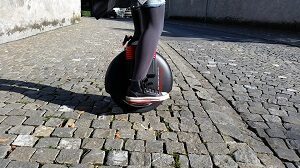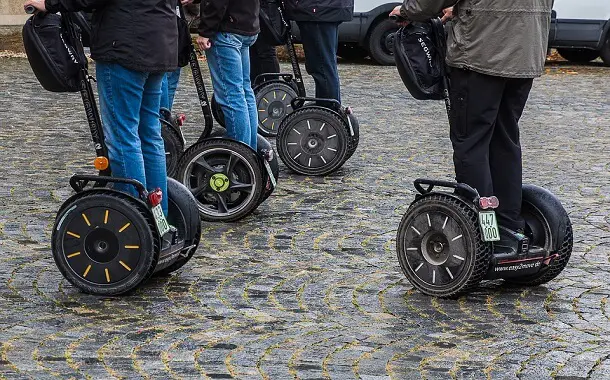How Much Does a Segway Cost?
Last Updated on February 4, 2024
Written by CPA Alec Pow | Content Reviewed by ![]() CFA Alexander Popinker
CFA Alexander Popinker
The Segway personal transporter revolutionized short-distance mobility when it was unveiled in 2001. But over 20 years later, how much do these futuristic-looking electric scooters cost?
Segway prices range widely based on the model, features, and buying options. This guide examines the different costs and key factors to consider when purchasing your own Segway.
A Segway is a self-balancing electric scooter controlled by shifts in the rider’s weight and movement. Internal gyroscopes detect the directional changes and automatically adjust the wheels.
This allows hands-free operation as you lean forward, back, left or right to maneuver. Segways provide an efficient way to travel 5-25 miles on a single battery charge.
Models designed for recreation, touring, and personal mobility offer speeds under 20mph. Sturdier commercial versions used by security and warehouses can reach 30 mph. Prices start around $400 for older used models and can exceed $5,000 for the highest-end versions.
How Much Does a Segway Cost?
Segway manufactures several models tailored for different uses. Prices vary based on the features offered.
Segway PT – The original Segway model was launched in 2001. Prices range from $400 for well-used units to $1,500 for updated PT models in good condition.
Segway i2 – The second generation model introduced in 2006 improves upon the classic PT. Expect prices from $1,200 for used i2 models up to $2,800 new ones.
Segway x2 – The x2 launched in 2008 with a more powerful engine and 10-inch wheels. New x2 models cost $4,000 to $5,000. Used prices are $1,500 to $3,000.
Segway Ninebot Electric – Acquired by Ninebot in 2015, newer Segways like the eMoped C and S-Pod models cost between $2,000 and $4,000 new.
Scooter Dojo, for example, writes that Segway models brand new can range anywhere from $599 to $10,000 for commercial use. The prices of pre-owned Segway i2 SE models on eBay vary considerably, but for a decent one, you can expect to pay somewhere in the range of $3,000 to $5,000. The Segway miniPro is typically sold for around $400 to $600 on Amazon.
Buda Segway Pest writes that the basic brand new Segway SE i2 package price is $6,000 in the U.S. and around €6,500 to €7,000 in Europe.
On the Segway Official Store you will find the following prices:
- Segway Dirt eBike X260: As low as $6,499.99
- Ninebot KickScooter MAX G30P: $899.99
- Ninebot KickScooter E25A: Regular price $769.99, sale price $499.99
What Impacts the Cost of a Segway?
Several factors influence the final price when buying a new or used Segway:
Range – Models with batteries allowing 15-25 miles per charge cost more than shorter-range versions.
Speed – Faster maximum speeds of 18-22 mph come at a premium.
Weight limit – Heavier payload capacities exceeding 260 pounds raise costs.
Features – Options like LED lights, custom colors, shock absorbers, and mobile apps add cost.
Accessories – Built-in cargo bins, racing trim, and all-terrain tires are pricey add-ons.
Condition – Used Segways in rougher shape with worn batteries and tires carry lower price tags.
Buying New vs Used: Pros and Cons
Purchasing a used Segway typically saves 50% or more compared to new models. However, there are some trade-offs to consider:
Used Pros: Lower sticker price, value deals on older models, may find lightly-ridden units, the opportunity to negotiate pricing.
Used Cons: No warranty protection, unknown maintenance history, older battery technology, risk of mechanical issues, limited features.
New Pros: Full warranty coverage, latest technology, and features, customize color/accessories, buy from an authorized dealer, current battery with full life.
New Cons: Much higher purchase price, limited discounts available, depreciates quickly after purchase.
Tips for used: Inspect condition closely, test functionality before buying, charge fully to check the battery, and confirm the software is updated.
Where to Buy a Segway
Segways are available from authorized dealers, private sellers, and specialty retailers:
- Segway.com – Purchase directly from the manufacturer online with models tailored for personal transportation or commercial/security use.
- Amazon – Large marketplace with new and used Segway models available from third-party sellers. Provides buyer protections.
- eBay – Similar to Amazon, features auctions and direct listings for used Segways with competitive pricing.
- Specialty retailers – Stores focused on personal transportation may carry select Segway models and offer expert guidance.
- Private sellers – An option for more significantly discounted used Segways, but higher risk. Test thoroughly before purchasing.
- Rental shops – Some renters sell off gently used rental units after 1-2 years of service at attractive prices.
Additional Costs of Segway Ownership
 Beyond the initial purchase price, owning a Segway also involves:
Beyond the initial purchase price, owning a Segway also involves:
- Safety gear – Helmet, kneepads, gloves to prevent injuries. (~$100)
- Maintenance – Tire/wheel replacement, battery refresh, fluid changes every 200-500 miles. (~$250/year)
- Insurance – Optional protection plans against theft, and damage. (~$80-$150/year)
- Accessories – Customize with bags, lights, fenders, and tires. (~$50-$500)
- Warranty – Extended warranty for component coverage. (~$300)
Maximizing Your Investment in a Segway
To make the most of your Segway purchase:
- Take a training class to safely learn to ride if new to Segways.
- Start slowly in open areas to get comfortable maneuvering before riding in traffic.
- Add protective accessories like fenders, lights, and grips to keep the Segway in top shape.
- Follow maintenance schedules and store indoors to preserve battery life and functionality.
- Save money by learning to change tires and perform repairs yourself.
- Join local Segway groups to meet other enthusiasts and learn about events.
Conclusion on Segway Electric Scooters
From functional used models under $1,000 to cutting-edge new versions beyond $5,000, Segways are a significant investment in personal transportation.
Considering your budget, features needed, and buying options allows finding the best value. Proper care and training maximizes the benefits of owning this innovative battery-powered mobility device.
Frequently Asked Questions
How fast can a Segway go?
The top speed of a Segway varies across models, ranging from about 6-15 mph on consumer versions to 20+ mph on some commercial models:
- Entry-level Segway i2 and x2 models reach 12.5 mph typically.
- Higher-end Ninebot eMopeds can hit 15 mph speeds.
- Lightweight Segway mini models and aging PTs max out around 8 mph.
- Commercial Segway i2s built for security and warehouses can reach 24 mph.
- Prototype Segway models have exceeded 35 mph, but are not available for purchase.
- Speed is electronically limited on all Segway variants for safety and legal compliance. Upgrades shouldn’t be attempted.
So in practical use, expect speeds of 8-15 mph on most Segways sold for personal transportation. Faster speeds are possible on commercial versions.
Why are Segways discontinued?
In 2020, Segway announced it would end production of its classic self-balancing scooters. This discontinuation was primarily due to:
- Declining sales and loss of market share to cheaper electric scooters.
- Higher manufacturing costs compared to competitors.
- Safety concerns and bans limiting widespread adoption.
- Lack of innovation and new features compared to rivals.
- Focus shifting from self balancing gadgets to other products like e-bikes, scooters, and mopeds.
However, models like the Segway Ninebot Gokart still integrate core Segway technology in different designs. And the secondhand market will continue supplying earlier popular models like the Segway PT and i2 to collectors and enthusiasts.
Is using a Segway hard?
Learning to ride and balance on a Segway takes practice, but most people can pick it up in a fairly short time. Here are some tips:
- Take advantage of training classes offered by dealers to learn proper techniques in a safe environment.
- Start off riding slowly in open flat areas free of obstacles to get a feel for making turns and stopping.
- Keep knees bent and body relaxed to aid balance by absorbing vibrations. Maintain a centered stance.
- Lean gently into turns using your core and hips, not just your arms. Keep movements smooth.
- Practice daily for at least 20-30 minutes until maintaining balance becomes second nature.
- Wear a helmet and elbow/knee pads in case of falls while building confidence.
So with some initial training and regular practice, most people find balancing and controlling a Segway manageable. Taking it slow and being safe early on helps make learning easy.


Leave a Reply
Want to join the discussion?Feel free to contribute!